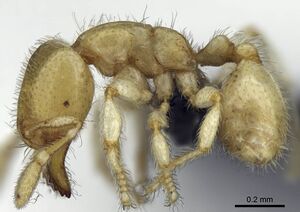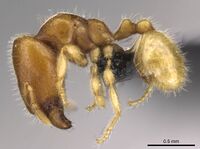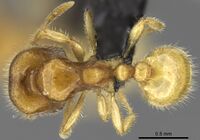Carebara hiragasy
| Carebara hiragasy | |
|---|---|

| |
| Scientific classification | |
| Kingdom: | Animalia |
| Phylum: | Arthropoda |
| Class: | Insecta |
| Order: | Hymenoptera |
| Family: | Formicidae |
| Subfamily: | Myrmicinae |
| Tribe: | Crematogastrini |
| Genus: | Carebara |
| Species: | C. hiragasy |
| Binomial name | |
| Carebara hiragasy Azorsa & Fisher, 2018 | |
A Madagascar forest species that has been found in soil and under stones.
Identification
Azorsa and Fisher (2018) - Antennae ten-segmented. Major: Head nearly subrectangular, posterior margin of head concave and posterolateral corners rounded; head with longitudinal rugae, not reaching posterolateral lobes, smooth and shiny frons, imbricate close to posterior margin of head; propodeum with posterodorsal corner nearly convex, dorsum flat; ventral face of petiole flat and petiolar node thick, combined outline of dorsal surface of peduncle and anterior face of node medially concave and posterior face vertical and convex. Minor: Head nearly subquadrate; propodeum with posterodorsal corner nearly convex, and dorsum flat; petiolar node thick, combined outline of dorsal surface of peduncle and anterior face of node slightly concave. There are no intermediate castes.
Carebara hiragasy is endemic to two localities in the southwest and southeast of Madagascar. The major workers are easily recognized by the following characters: head longer than wide, with the posterolateral corners rounded; the propodeum unarmed; and the anterodorsal corner of the petiole convex. In minor workers: the head nearly subquadrate; the propodeum unarmed; and long erect to suberect hairs on the head and body, except for those on the scape and tibia which are decumbent. Nine other species were recorded at the same localities: Carebara bara, Carebara dota, Carebara grandidieri, Carebara hainteny, Carebara jajoby, Carebara nosindambo, Carebara omasi, Carebara placida and Carebara sampi, but C. hiragasy can be separated from the others by the combination of characters mentioned above.
Keys including this Species
Distribution
Azorsa and Fisher (2018) - Carebara hiragasy is known only from the southwestern and southeastern sections of Madagascar. This species was found in montane rainforest and rainforest (transition to montane forest) at 600 m and 1100 m.
Latitudinal Distribution Pattern
Latitudinal Range: -18.91813° to -22.791°.
| North Temperate |
North Subtropical |
Tropical | South Subtropical |
South Temperate |
- Source: AntMaps
Distribution based on Regional Taxon Lists
Malagasy Region: Madagascar (type locality).
Distribution based on AntMaps
Distribution based on AntWeb specimens
Check data from AntWeb
Countries Occupied
| Number of countries occupied by this species based on AntWiki Regional Taxon Lists. In general, fewer countries occupied indicates a narrower range, while more countries indicates a more widespread species. |

|
Estimated Abundance
| Relative abundance based on number of AntMaps records per species (this species within the purple bar). Fewer records (to the left) indicates a less abundant/encountered species while more records (to the right) indicates more abundant/encountered species. |

|
Biology
Castes
Worker
Images from AntWeb
   
| |
| Paratype of Carebara hiragasy. Worker. Specimen code casent0496888. Photographer Frank Azorsa, uploaded by California Academy of Sciences. | Owned by CAS, San Francisco, CA, USA. |
Nomenclature
The following information is derived from Barry Bolton's Online Catalogue of the Ants of the World.
- hiragasy. Carebara hiragasy Azorsa & Fisher, 2018: 71, figs. 42, 68 (s.w.) MADAGASCAR.
- Type-material: holotype major worker, 2 paratype major workers, 11 paratype minor workers.
- Type-locality: holotype Madagascar: Toliara, Forêt Classée d’Analavelona, 29.2 km. 343° NNW Mahaboboka, -22.675, 44.19, 1100 m., 18-22.ii.2003, BLF07838, montane rainforest (B.L. Fisher, C.E. Griswold, et al.); paratypes: 2 major workers, 6 minor workers with same data, 5 minor worker with same data but BLF07820, BLF07827, and BLF07848.
- Type-depositories: CASC (holotype); BMNH, CASC, MCZC, MHNG (paratypes).
- Distribution: Madagascar.
Unless otherwise noted the text for the remainder of this section is reported from the publication that includes the original description.
Description
Worker
Major. (n=3): HL 0.74–1.03 (0.87); HW 0.58–0.79 (0.66); SL 0.31–0.39 (0.35); ML 0.20–0.27 (0.22); EL 0.02–0.05 (0.02); EM 0.21–0.34 (0.30); HD 0.42–0.61 (0.50); WL 0.67–0.88 (0.80); PSL 0.04–0.07 (0.06); PW 0.39–0.53 (0.46); MFL 0.36–0.50 (0.43); MFW 0.08–0.12 (0.11); MTL 0.29–0.39 (0.34); PTL 0.22–0.30 (0.26); PNL 0.12–0.15 (0.13); PTH 0.16–0.21 (0.18); PTW 0.16–0.21 (0.18); PPL 0.16–0.20 (0.17); PPNL 0.12–0.18 (0.15); PPH 0.14–0.21 (0.17); PPW 0.18–0.24 (0.21); GL 0.52–0.75 (0.61); GW 0.47–0.75 (0.61); CI 76–78 (76); MI 25–27 (25); SI 38–42 (40), MLI 62–65 (65); PPLI 65–73 (65); PPI 113–117 (117); PSI 7–9 (9).
Head longer than wide (CI 76–78), in full-face view roughly subrectangular, about 1.3 times longer than wide. Posterior margin of head medially concave, posterolateral corners rounded, lateral margins straight. Mandibles with six teeth. Anterior margin of clypeus slightly concave, and laterally convex. Antennae with ten segments. Scapes short (HL 0.74–1.03, SL 0.31–0.39, SI 38–42), barely surpassing cephalic midlength. Ocelli present or absent. Eyes present, consisting of one ommatidium (EL 0.02–0.05). Supraclypeal area well defined, acutely triangular with a short longitudinal strip posteriorly, not reaching cephalic midlength.
In profile view, promesonotum high and strongly convex, metanotal groove deeply impressed, propodeum lower than promesonotum. Propodeum about as high as long, dorsal face of propodeum nearly flat and declining posteriorly, propodeum unarmed, posterodorsal corner bluntly angled, declivity of propodeum vertical and slightly con cave. Propodeal lobes short and convex. Propodeal spiracle rounded and situated above mid-height of sclerite by about 1.5 times the diameter of the spiracle, and beyond mid-length of sclerite by about two times the diameter of the spiracle, distance from propodeal spiracle to posterodrosal corner of propodeum about 1.8 times the diameter of the spiracle (PSL 0.04–0.07), and distance to declivity same as the diameter of the spiracle. In dorsal view, promesonotum about as long as wide, anterior margin and sides of promesonotum rounded, deeply narrowed posteriorly; sides of propodeum straight.
Petiole longer than high (PTL 0.22–0.30, PTH 0.16–0.21) and with relatively short peduncle, ventral face slightly convex. Petiolar node thick. Combined outline of dorsal surface of peduncle and anterior face of node slightly concave in the middle, posterior face of node vertical and weakly convex, anterodorsal corner convex, posterodorsal corner rounded, dorsum convex. Subpetiolar process produced as denticle, about as long as the diameter of the propodeal spiracle. Postpetiolar node rounded and lower than petiolar node. In dorsal view, petiolar node not as wide as postpetiolar node (PTW 0.16–0.21, PPW 0.18–0.24), petiolar node wider than long (PTW 0.16–0.21, PNL 0.12–0.15), anterior and posterior margins of petiole slightly convex, and nearly straight in postpetiole, sides rounded in petiole and postpetiole.
Dorsal surface of mandibles and head with scattered piligerous punctae. Frontoclypeal area, frons, and posterolateral portion of cephalic dorsum smooth and shiny. Head with longitudinal and parallel carinulae, extending from gena and frontal lobes to posterolateral corners, clypeus with transverse rugae. Mandibles with longitudinal striations, weakly imbricate close to posterior margin of head. In profile, posterolateral portion of cephalic dorsum smooth and shiny medially. Mesosoma smooth and shiny, except for katepisternum, metapleuron and propodeum, which are areolate. Longitudinal and fine carinulae present on lateral side of pronotum. Petiole and ventral face of postpetiole areolate. In dorsal view, promesonotum, petiole, postpetiole and gaster smooth and shiny; propodeum weakly sculptured.
Lateral margins, posterolateral corners, and posterior margin of head with short and long erect to suberect hairs. Scapes with appressed hairs. Outer margin of mandible with a few and very short appressed hairs. Mesosoma with short and long erect hairs. Petiole and postpetiole with long suberect and subdecumbent hairs. Tibia with decumbent hairs. Gaster with short subdecumbent hairs and long erect hairs. Color yellowish ferruginous.
Minor. (n=8): HL 0.43–0.50; HW 0.41– 0.45; SL 0.29–0.32; ML 0.12–0.15; EL 0.01–0.02; EM 0.14–0.18; HD 0.27–0.31; WL 0.50–0.57; PSL 0.03–0.04; PW 0.26–0.30; MFL 0.29–0.35; MFW 0.07–0.08; MTL 0.24–0.27; PTL 0.15–0.18; PNL 0.09–0.10; PTH 0.13–0.14; PTW 0.11–0.13; PPL 0.11–0.14; PPNL 0.09–0.11; PPH 0.10–0.12; PPW 0.14–0.17; GL 0.43–0.61; GW 0.36–0.42; CI 90–100; MI 27–31; SI 64–68; MLI 67–78; PPLI 69–81; PPI 119–132; PSI 7–9.
Head slightly longer than wide (CI 90–100), in full-face view nearly subquadrate, about 1.03 times longer than wide. Posterior margin of head nearly straight, posterolateral corners convex, lateral margins convex. Mandibles with five teeth. Anterior margin of clypeus weakly concave medially and laterally angulate. Antennae with ten segments. Scape fails to reach the posterior margin of head (HL 0.43–0.50, SL 0.29–0.32, SI 64–68). Eyes present, consisting of two ommatidia (EL 0.01–0.02). Supraclypeal area triangular but poorly defined.
In profile view, promesonotum weakly convex, nearly flat, metanotal groove deeply impressed. Propodeum about as high as long, dorsal face of propodeum flat and declining posteriorly, posterodorsal corner bluntly angled, anterodorsal corner rounded, declivity vertical and slightly concave. Propodeal lobes short and convex. Propodeal spiracle rounded and situated slightly above mid-height of sclerite by about half the diameter of the spiracle, and beyond mid-length of sclerite by about the diameter of the spiracle, distance from propodeal spiracle to posterodorsal corner of propodeum and to declivity same as the diameter of the spiracle (PSL 0.03–0.04). In dorsal view, promesonotum almost as long as wide (about 1.06 times longer than wide), anterior margin of promesonotum rounded, sides convex; sides of propodeum weakly convex.
Petiole slightly longer than high (PTL 0.15–0.18, PTH 0.13–0.14) and with a short peduncle, ventral face medially convex. Combined outline of dorsal surface of peduncle and anterior face of node slightly concave, nearly straight, posterior face of node vertical and nearly straight, anterodorsal corner convex, posterodorsal corner rounded, dorsum convex. Subpetiolar process produced as a small denticle, smaller than the diameter of the propodeal spiracle. Petiolar node thick. Postpetiolar node rounded and lower than petiolar node. In dorsal view, postpetiolar node wider than petiolar node (PPW 0.14–0.17, PTW 0.11–0.13), petiolar node wider than long (PTW 0.11–0.13, PNL 0.09–0.10), anterior and posterior margin of petiole slightly convex, and nearly straight in postpetiole, sides of petiole rounded and convex in postpetiole.
Dorsal surface of head, mandibles, clypeus and supraclypeal area smooth and shiny, with scattered piligerous punctae on head and mandibles, gena and frontal lobes longitudinally carinulate. Mesosoma smooth and shiny, except for katepisternum (areolate), and metapleuron (finely and longitudinally areolate). Petiole and ventral face of postpetiole areolate. In dorsal view, mesosoma, petiole, postpetiole and gaster smooth and shiny, except for declivity of propodeum which is weakly sculptured.
Lateral margins and posterior margin of head with suberect hairs. Scapes with subdecumbent hairs. Outer margin of mandible with short decumbent hairs. Mesosoma with long and short erect hairs. Petiole, postpetiole and gaster with abundant subdecumbent hairs, and sparse and long suberect hairs. Tibia with decumbent hairs. Color yellowish ferruginous.
Type Material
Holotype. (major worker), Madagascar Toliara, Forêt Classée d’Analavelona, 29.2 km 343° NNW Mahaboboka, -22.675, 44.19, 1100 m, montane rainforest, 18–22.ii.2003, (Fisher, Griswold et al.). Collection code BLF07838, (California Academy of Sciences: CASENT0906501). Paratypes: (2 major workers and 6 minor workers), with same data as holotype, 2 major workers (CASC: CASSENT0906495, CASENT0906496), and 1 minor worker (CASC: CASENT0496888). 5 minor workers with same data as holotype but with different collection codes. BLF07820. (The Natural History Museum: CASENT0498240), BLF07827, (CASC: CASENT0498241, CASENT0498242), BLF07848, (Museum of Comparative Zoology: CASENT0498224, Musee d'Histoire Naturelle Genève: CASENT0498223).

